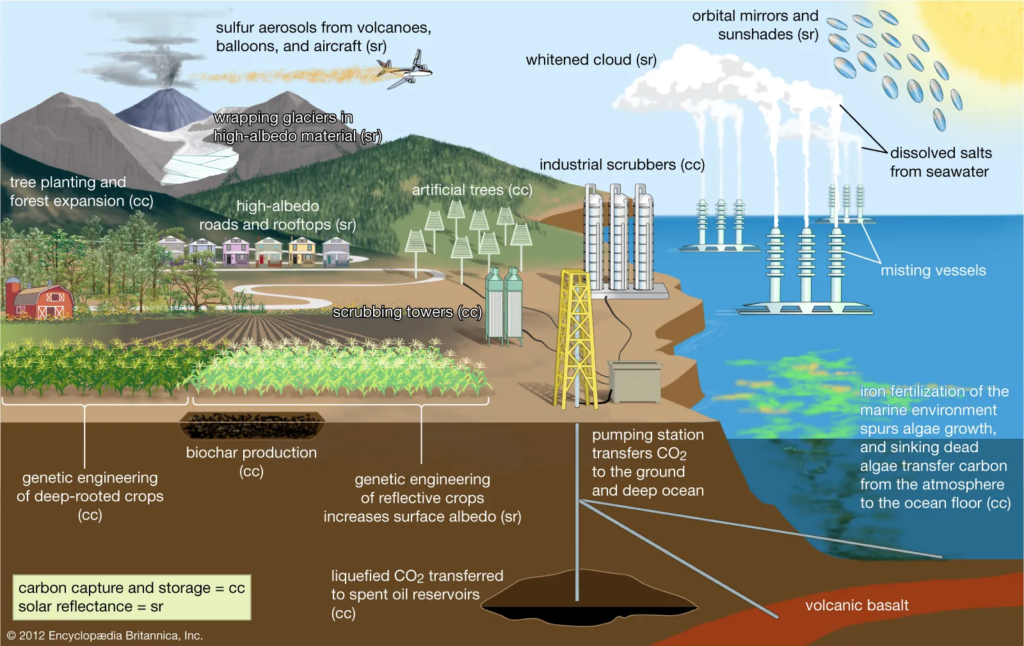Welcome to the frontlines of climate innovation, where scientists, engineers, and visionaries are exploring bold strategies to combat the escalating crisis of climate change. Climate engineering—or geoengineering, as it’s often known—refers to a suite of techniques designed to deliberately manipulate the Earth’s climatic systems. These approaches have captured the imagination of policymakers and environmentalists alike, either as a necessary complement to traditional mitigation strategies or as a tempting shortcut to addressing our ecological woes.

Advertisement-1 For PRODUCTS, INSTITUTION, UNIVERSITY & COMPANY PROMOTION, Email to mgsdigitalsolutions@gmail.com
What is Climate Engineering?
Climate engineering, according to Harvard’s Solar Geoengineering Program, is a broad category of technologies meant to alter the climate in order to reduce climate change. There are two main types of climate engineering: carbon dioxide removal and solar radiation management. At its core, climate engineering seeks to either remove carbon dioxide from the atmosphere or to alter the climate’s natural processes to reflect solar radiation away from Earth. Two broad categories minimize the immediate consequences of climate change:
- Carbon Dioxide Removal (CDR): This includes technologies such as direct air capture, ocean fertilization, and afforestation. The goal here is to sequester excess carbon from the atmosphere to return to pre-industrial levels.
- Solar Radiation Management (SRM): These techniques aim to cool the planet by reflecting sunlight back into space. Approaches range from injecting sulfur dioxide into the stratosphere to deploying space-based reflectors.
The Promise of Climate Engineering
As we teeter on the edge of climate catastrophe, the potential benefits of climate engineering are undeniable. From preventing devastating sea level rise to preserving ecosystems at risk, these strategies could play a critical role in averting widespread disaster. With global warming threatening food security, biodiversity, and water resources, such innovations could provide essential breathing room while we transition to more sustainable practices.
Moreover, in a world where governmental and individual action alone often seem insufficient, climate engineering unfolds the possibility of restoring balance—quickly and efficiently—pending widespread societal change.
The Perils of Playing God
However, with great promise comes great risk. Unintended consequences loom large on the horizon. The complex and interconnected systems of the Earth’s atmosphere and ecosystems could be disrupted in unpredictable ways. For instance, SRM could lead to drastic changes in rainfall patterns, jeopardizing agriculture and water resources. Meanwhile, focusing heavily on CDR could detract from essential policy-driven change and personal responsibility needed to curb emissions.
Moreover, the ethical implications warrant careful consideration; Who gets to decide on such significant changes? How do we handle the governance of global climate interventions? A course correction could exacerbate social inequities, particularly if wealthy nations deploy these tactics while poorer nations bear the brunt of any negative consequences.
The Path Forward
A collaborative and open-minded approach can ensure that the exploration of climate engineering does not come at the expense of widespread environmental initiatives. Research must proceed with transparency, underwriting regulations and global governance to mitigate risks. Engaging diverse perspectives—including those of marginalized communities—is vital for reaching equitable agreements on the responsible use of these technologies.

The key lies in viewing climate engineering not as a silver bullet, but as just one element within a larger tapestry of sustainable policy and behavior change. Fossil fuel reduction, reforestation initiatives, sustainable agriculture, and bike infrastructure all play roles that can ensure a resilient future.
Advertisement-2 For PRODUCTS, INSTITUTION, UNIVERSITY, COMPANY PROMOTION, Email to mgsdigitalsolutions@gmail.com
Conclusion
Climate engineering dances on a knife’s edge between a hopeful promise and a perilous path. As we gather data, foster discourse, and innovate, we must tread carefully within the labyrinthine nature of Earth’s systems. By blending technology with profound respect for nature, we have the chance not only to forge solutions but also to rediscover our shared responsibility for the planet—a challenge crying out for creativity, compassion, and cooperation.
For more about careers in Environmental Engineering areas, visit on http://www.icareerkick-mgs.in
IOS ?шін 888starz ?осымшасын тегін орнатып, шектеусіз ойын баста?ыз.
https://onlinetri.com/common/pgs/888starz-site-officiel_1.html 888starz
account exchange service accounts marketplace
website for buying accounts sell accounts
buy account account trading platform
website for selling accounts gaming account marketplace
sell accounts account selling service
social media account marketplace profitable account sales
profitable account sales website for buying accounts
ready-made accounts for sale database of accounts for sale
purchase ready-made accounts account buying platform
sell accounts website for selling accounts
account acquisition marketplace for ready-made accounts
gaming account marketplace account selling service
account buying service guaranteed accounts
accounts marketplace guaranteed accounts
purchase ready-made accounts account exchange service
account buying platform sell accounts
account buying service find accounts for sale
account market database of accounts for sale
account market online account store
sell account account store
gaming account marketplace https://accounts-offer.org
account selling service accounts market
buy pre-made account https://buy-best-accounts.org
find accounts for sale https://social-accounts-marketplaces.live
account trading platform https://accounts-marketplace.live
buy accounts https://social-accounts-marketplace.xyz/
accounts marketplace accounts market
purchase ready-made accounts https://buy-accounts-shop.pro
account market https://accounts-marketplace.art
account buying service https://social-accounts-marketplace.live/
accounts for sale https://buy-accounts.live
account selling service https://accounts-marketplace.online
buy account https://accounts-marketplace-best.pro
купить аккаунт https://akkaunty-na-prodazhu.pro
маркетплейс аккаунтов соцсетей https://rynok-akkauntov.top
биржа аккаунтов kupit-akkaunt.xyz
купить аккаунт https://akkaunt-magazin.online/
площадка для продажи аккаунтов https://akkaunty-market.live
маркетплейс аккаунтов https://kupit-akkaunty-market.xyz/
магазин аккаунтов https://akkaunty-optom.live/
покупка аккаунтов online-akkaunty-magazin.xyz
маркетплейс аккаунтов akkaunty-dlya-prodazhi.pro
покупка аккаунтов https://kupit-akkaunt.online
buy fb ads account https://buy-adsaccounts.work/
buy facebook profiles https://buy-ad-accounts.click
facebook accounts for sale https://buy-ad-account.top
buy fb ad account https://buy-ads-account.click
facebook accounts for sale https://ad-account-buy.top
buy facebook account for ads cheap facebook advertising account
facebook ad accounts for sale https://ad-account-for-sale.top
buy a facebook ad account buy facebook account for ads
buy accounts facebook https://ad-accounts-for-sale.work
buy google ads threshold account adwords account for sale
google ads accounts for sale https://buy-ads-accounts.click
buy account facebook ads facebook accounts to buy
buy old google ads account https://ads-account-for-sale.top/
buy google ads invoice account https://ads-account-buy.work
google ads agency accounts google ads account for sale
buy google ads invoice account https://buy-account-ads.work/
buy verified google ads accounts buy google ad threshold account
buy google ads invoice account google ads reseller
buy facebook business manager account https://buy-business-manager.org/
google ads reseller https://buy-verified-ads-account.work
buy google ads threshold accounts google ads agency accounts
buy facebook verified business manager https://buy-business-manager-acc.org/
facebook business account for sale buy fb business manager
verified bm for sale facebook bm for sale
buy verified facebook business manager https://buy-verified-business-manager.org/
facebook business manager for sale buy verified bm
buy verified facebook business manager buy-business-manager-verified.org
buy facebook business manager accounts buy-bm.org
facebook verified business manager for sale buy facebook verified business account
buy facebook bm https://buy-business-manager-accounts.org/
tiktok ad accounts https://buy-tiktok-ads-account.org
tiktok ad accounts tiktok ads account buy
tiktok ads account for sale https://tiktok-ads-account-for-sale.org
buy tiktok business account https://tiktok-agency-account-for-sale.org
buy tiktok ad account https://buy-tiktok-ad-account.org
buy tiktok ads account https://buy-tiktok-ads-accounts.org
buy tiktok ad account https://buy-tiktok-business-account.org
tiktok ad accounts https://buy-tiktok-ads.org
tiktok ad accounts https://tiktok-ads-agency-account.org